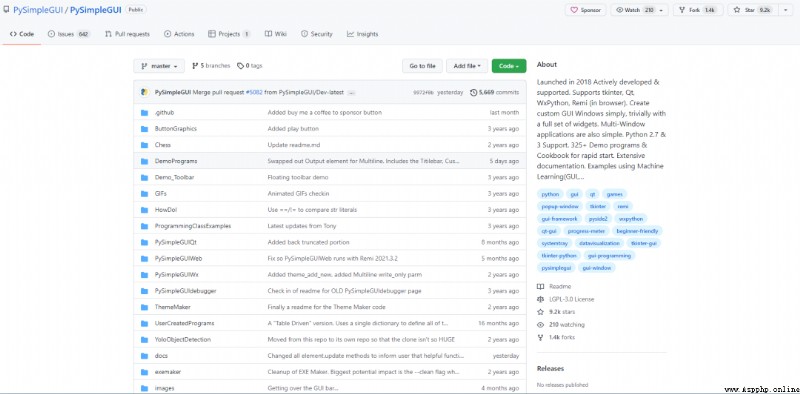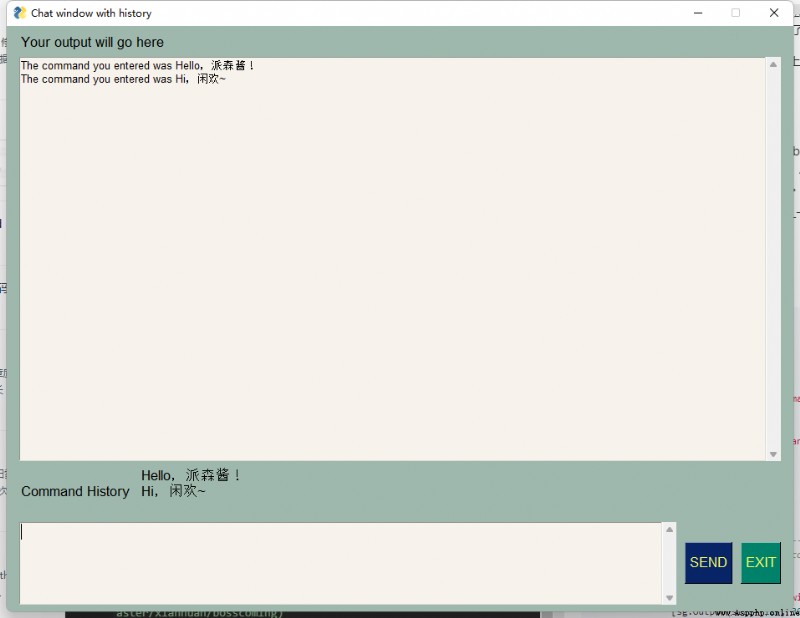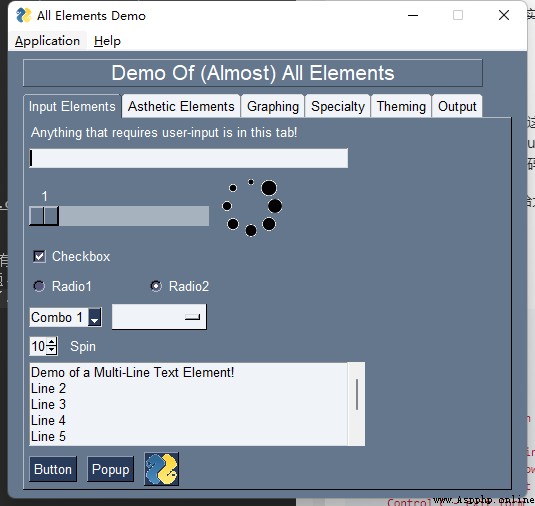Today, I'd like to introduce a python Of GUI Artifact —— PySimpleGUI, This library is really simple , Except the interface is a little bit “ original ”, Nothing else is wrong .
It's like PySimpleGUI This kind of GUI Interface , Follow Web Pages are not comparable , The latter is simply too easy to be beautiful . and GUI The interface is designed to generate executable software , Congenital deficiency in aesthetics .
PySimpleGUI yes python GUI The best in the framework , It is suitable for quickly generating simple and elegant GUI. Use it to write GUI It's already relatively fast , So is there a faster way ?
The answer is yes , This article will reveal for you !
PySimpleGUI stay GitHub The address on is :
https://github.com/PySimpleGUI/PySimpleGUI
You can visit , Its homepage is like this :

There is a lot of content, isn't it ?
There is an important content , stay DemoPrograms Under the folder , This folder is written by the author demo example . The author really understands the psychology of us slackers , Even with such a simple and easy-to-use GUI frame , It's time to write examples , We may also search for instances on the Internet , Then use CV Dafa . The framework author may expect this , So he wrote many different examples himself , Let you really use it .
There are probably 300 More than one instance , Basically, it can cover our usual use python Write GUI Various components and layouts that can be encountered .
With this artifact , We just need to put this GitHub Copy the items on to the local , Then run these instances again , Roughly know each instance u What is . Follow up when we want to write GUI when , We just need to find the corresponding instance , Then copy the code . Is it simple ?
Let me run a few demo , Show you what the examples look like .
Let's copy the source code first :
#!/usr/bin/env python
import PySimpleGUI as sg
''' A chatbot with history Scroll up and down through prior commands using the arrow keys Special keyboard keys: Up arrow - scroll up in commands Down arrow - scroll down in commands Escape - clear current command Control C - exit form '''
def ChatBotWithHistory():
# ------- Make a new Window ------- #
# give our form a spiffy set of colors
sg.theme('GreenTan')
layout = [[sg.Text('Your output will go here', size=(40, 1))],
[sg.Output(size=(127, 30), font=('Helvetica 10'))],
[sg.Text('Command History'),
sg.Text('', size=(20, 3), key='history')],
[sg.ML(size=(85, 5), enter_submits=True, key='query', do_not_clear=False),
sg.Button('SEND', button_color=(sg.YELLOWS[0], sg.BLUES[0]), bind_return_key=True),
sg.Button('EXIT', button_color=(sg.YELLOWS[0], sg.GREENS[0]))]]
window = sg.Window('Chat window with history', layout,
default_element_size=(30, 2),
font=('Helvetica', ' 13'),
default_button_element_size=(8, 2),
return_keyboard_events=True)
# ---===--- Loop taking in user input and using it --- #
command_history = []
history_offset = 0
while True:
event, value = window.read()
if event == 'SEND':
query = value['query'].rstrip()
# EXECUTE YOUR COMMAND HERE
print('The command you entered was {}'.format(query))
command_history.append(query)
history_offset = len(command_history)-1
# manually clear input because keyboard events blocks clear
window['query'].update('')
window['history'].update('\n'.join(command_history[-3:]))
elif event in (sg.WIN_CLOSED, 'EXIT'): # quit if exit event or X
break
elif 'Up' in event and len(command_history):
command = command_history[history_offset]
# decrement is not zero
history_offset -= 1 * (history_offset > 0)
window['query'].update(command)
elif 'Down' in event and len(command_history):
# increment up to end of list
history_offset += 1 * (history_offset < len(command_history)-1)
command = command_history[history_offset]
window['query'].update(command)
elif 'Escape' in event:
window['query'].update('')
ChatBotWithHistory()
Run it , Look at the effect :
This is a chat software with history , If you need to make a similar software , You can copy the code directly , Then change it a little .
Let's take another example :
#!/usr/bin/env python
""" Example of (almost) all Elements, that you can use in PySimpleGUI. Shows you the basics including: Naming convention for keys Menubar format Right click menu format Table format Running an async event loop Theming your application (requires a window restart) Displays the values dictionary entry for each element And more! Copyright 2021 PySimpleGUI """
import PySimpleGUI as sg
def make_window(theme):
sg.theme(theme)
menu_def = [['&Application', ['E&xit']],
['&Help', ['&About']] ]
right_click_menu_def = [[], ['Nothing','More Nothing','Exit']]
# Table Data
data = [["John", 10], ["Jen", 5]]
headings = ["Name", "Score"]
input_layout = [[sg.Menu(menu_def, key='-MENU-')],
[sg.Text('Anything that requires user-input is in this tab!')],
[sg.Input(key='-INPUT-')],
[sg.Slider(orientation='h', key='-SKIDER-'),
sg.Image(data=sg.DEFAULT_BASE64_LOADING_GIF, enable_events=True, key='-GIF-IMAGE-'),],
[sg.Checkbox('Checkbox', default=True, k='-CB-')],
[sg.Radio('Radio1', "RadioDemo", default=True, size=(10,1), k='-R1-'), sg.Radio('Radio2', "RadioDemo", default=True, size=(10,1), k='-R2-')],
[sg.Combo(values=('Combo 1', 'Combo 2', 'Combo 3'), default_value='Combo 1', readonly=True, k='-COMBO-'),
sg.OptionMenu(values=('Option 1', 'Option 2', 'Option 3'), k='-OPTION MENU-'),],
[sg.Spin([i for i in range(1,11)], initial_value=10, k='-SPIN-'), sg.Text('Spin')],
[sg.Multiline('Demo of a Multi-Line Text Element!\nLine 2\nLine 3\nLine 4\nLine 5\nLine 6\nLine 7\nYou get the point.', size=(45,5), k='-MLINE-')],
[sg.Button('Button'), sg.Button('Popup'), sg.Button(image_data=sg.DEFAULT_BASE64_ICON, key='-LOGO-')]]
asthetic_layout = [[sg.T('Anything that you would use for asthetics is in this tab!')],
[sg.Image(data=sg.DEFAULT_BASE64_ICON, k='-IMAGE-')],
[sg.ProgressBar(1000, orientation='h', size=(20, 20), key='-PROGRESS BAR-'), sg.Button('Test Progress bar')]]
logging_layout = [[sg.Text("Anything printed will display here!")], [sg.Output(size=(60,15), font='Courier 8')]]
graphing_layout = [[sg.Text("Anything you would use to graph will display here!")],
[sg.Graph((200,200), (0,0),(200,200),background_color="black", key='-GRAPH-', enable_events=True)],
[sg.T('Click anywhere on graph to draw a circle')],
[sg.Table(values=data, headings=headings, max_col_width=25,
background_color='black',
auto_size_columns=True,
display_row_numbers=True,
justification='right',
num_rows=2,
alternating_row_color='black',
key='-TABLE-',
row_height=25)]]
specalty_layout = [[sg.Text("Any \"special\" elements will display here!")],
[sg.Button("Open Folder")],
[sg.Button("Open File")]]
theme_layout = [[sg.Text("See how elements look under different themes by choosing a different theme here!")],
[sg.Listbox(values = sg.theme_list(),
size =(20, 12),
key ='-THEME LISTBOX-',
enable_events = True)],
[sg.Button("Set Theme")]]
layout = [[sg.Text('Demo Of (Almost) All Elements', size=(38, 1), justification='center', font=("Helvetica", 16), relief=sg.RELIEF_RIDGE, k='-TEXT HEADING-', enable_events=True)]]
layout +=[[sg.TabGroup([[ sg.Tab('Input Elements', input_layout),
sg.Tab('Asthetic Elements', asthetic_layout),
sg.Tab('Graphing', graphing_layout),
sg.Tab('Specialty', specalty_layout),
sg.Tab('Theming', theme_layout),
sg.Tab('Output', logging_layout)]], key='-TAB GROUP-')]]
return sg.Window('All Elements Demo', layout, right_click_menu=right_click_menu_def)
def main():
window = make_window(sg.theme())
# This is an Event Loop
while True:
event, values = window.read(timeout=100)
# keep an animation running so show things are happening
window['-GIF-IMAGE-'].update_animation(sg.DEFAULT_BASE64_LOADING_GIF, time_between_frames=100)
if event not in (sg.TIMEOUT_EVENT, sg.WIN_CLOSED):
print('============ Event = ', event, ' ==============')
print('-------- Values Dictionary (key=value) --------')
for key in values:
print(key, ' = ',values[key])
if event in (None, 'Exit'):
print("[LOG] Clicked Exit!")
break
elif event == 'About':
print("[LOG] Clicked About!")
sg.popup('PySimpleGUI Demo All Elements',
'Right click anywhere to see right click menu',
'Visit each of the tabs to see available elements',
'Output of event and values can be see in Output tab',
'The event and values dictionary is printed after every event')
elif event == 'Popup':
print("[LOG] Clicked Popup Button!")
sg.popup("You pressed a button!")
print("[LOG] Dismissing Popup!")
elif event == 'Test Progress bar':
print("[LOG] Clicked Test Progress Bar!")
progress_bar = window['-PROGRESS BAR-']
for i in range(1000):
print("[LOG] Updating progress bar by 1 step ("+str(i)+")")
progress_bar.UpdateBar(i + 1)
print("[LOG] Progress bar complete!")
elif event == "-GRAPH-":
graph = window['-GRAPH-'] # type: sg.Graph
graph.draw_circle(values['-GRAPH-'], fill_color='yellow', radius=20)
print("[LOG] Circle drawn at: " + str(values['-GRAPH-']))
elif event == "Open Folder":
print("[LOG] Clicked Open Folder!")
folder_or_file = sg.popup_get_folder('Choose your folder')
sg.popup("You chose: " + str(folder_or_file))
print("[LOG] User chose folder: " + str(folder_or_file))
elif event == "Open File":
print("[LOG] Clicked Open File!")
folder_or_file = sg.popup_get_file('Choose your file')
sg.popup("You chose: " + str(folder_or_file))
print("[LOG] User chose file: " + str(folder_or_file))
elif event == "Set Theme":
print("[LOG] Clicked Set Theme!")
theme_chosen = values['-THEME LISTBOX-'][0]
print("[LOG] User Chose Theme: " + str(theme_chosen))
window.close()
window = make_window(theme_chosen)
window.close()
exit(0)
if __name__ == '__main__':
main()
Let's see the effect after running :
This demo yes PySimpleGUI A collection of all components , every last tab It's all a category . This includes the progress bar 、 canvas 、 The theme 、 Scroll bars and so on . If you want to find interface components , To this demo Just look in the source code of .
There are more examples , Let's explore by ourselves ! Here is mainly to introduce you to a rapid development GUI Methods , Be commonly called CV Dafa . But this is just a way of rapid development , You still have time to look at the source code , It's better to understand the principle !